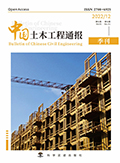

单节点交叉裂隙是离散裂隙网络的基本组成单元。本文通过实验方法对单节点交叉裂隙模型中油水两相流流动特性进行了研究。将模型按角度不同分为十六组, 在每组实验过程中依次改变油、水相流速, 实验时控制油、水相流速一直在低流速范围内。使用高速摄像机对实验中流体的流动过程进行记录, 并对结果进行详细分析。在低速流条件下, 油水两相在裂隙中呈弹状流。同时考虑油水相流速和裂隙交叉角度对水段长度和水油段长度比的影响。采用蠕动泵转速代替流速进行讨论, 结果表明: 对于同一交叉裂隙角度模型, 当水泵转速不变时, 水段长度随油泵转速增大逐渐减小, 二者呈幂函数的形式变化。当油泵转速不变时, 随着水泵转速的增大, 水段长度和水油段长度比逐渐增大, 分别呈线性和幂函数形式变化。在不同油泵、水泵转速下, 裂隙交叉角度对水段长和水油段长度比的影响规律不同。
Single-node cross fracture is the basic unit of discrete fracture network. In this paper, the flow characteristics of oil-water two-phase flow in single-node cross fracture model are investigated by experimental method. The model was divided into sixteen groups according to different angles, the oil and water phase flow rates were changed sequentially in each group and the velocity of oil and water phase were controlled to be in the low velocity flow rate range all the time during the experiment. The fluid flow process was recorded during the experiment by using the high-speed camera and the results were analyzed in detail. Under the condition of low velocity flow, oil-water two phases were slug flow in fracture. Effects of fracture crossing angle and oil-water phase velocity on the length of water section and the ratio of water-oil section length were also considered. The peristaltic pump speed is used instead of flow rate for the discussion, and the results show that for the same cross-fracture angle model, when the water pump speed is unchanged, the length of the water section gradually decreases in the form. of a power function with the increase of the speed of the oil pump. When the oil pump speed is unchanged, as the water pump speed increases, the length of water section increases in the form. of a linear function and the length ratio of wateroil section increases in the form. of the power function. Under different speeds of oil pump and water pump, the influence of fracture crossing angle on the length of water section and the length ratio of water-oil section is different.